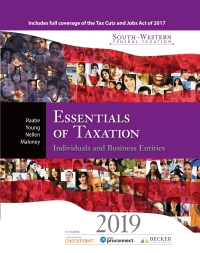On what date did Village's S status become effective? a. January 1, year 4 b. January 1,
Question:
On what date did Village's S status become effective?
a. January 1, year 4
b. January 1, year 5
c. December 5, year 4
d. December 5, year 5 2. Fox Corp., an S corporation, had an ordinary loss of $36,500 for the year ended December 31, year 2. At January 1, year 2, Duffy owned 50% of Fox's stock. Duffy held the stock for 40 days in year 2 before selling the entire 50% interest to an unrelated third party, Duffy's basis for the stock was $10,000. Duffy was a full-time employee of Fox until the stock was sold. Duffy's share of Fox's loss was:
a. $0
b. $2,000
c. $10,000
d. $18,250 3. An S corporation has 30,000 shares of voting common stock and 20,000 shares of nonvoting common stock issued and outstanding. The S election can be revoked vol- untarily with the consent of the shareholders holding, on the day of the revocation, the following number of outstanding shares. Shares of Voting Stock Shares of Nonvoting Stock
a. 0
b. 7,500 C.
d. 10,000 20,000 20,000 5,000 16,000 0 4. The Haas Corp., a calendar year S corporation, has two equal shareholders. For the year ended December 31, year 6, Haas had net income of $60,000, which included $50,000 from operations and $10,000 from investment interest income. There were no other transactions that year. Each shareholder's basis in the stock of Haas will increase by:
a. $50,000
b. $30,000
c. $25,000
d. $0 5. Zinco Corp. was a calendar year S corporation. Zinco's S status terminated on April 1, year 6, when Case Corp. became a shareholder. During year 6 (365-day calendar year), Zinco had nonseparately computed income of $310,250. If no election was made by Zinco, what amount of the income, if any, was allocated to the S short year for year (?
a. $233,750
c. $76,500
b. $155,125
d. $0
Step by Step Answer:

Essentials Of Taxation Individuals And Business Entities 2019
ISBN: 9780357233290
1st Edition
Authors: William A Raabe, James C Young





